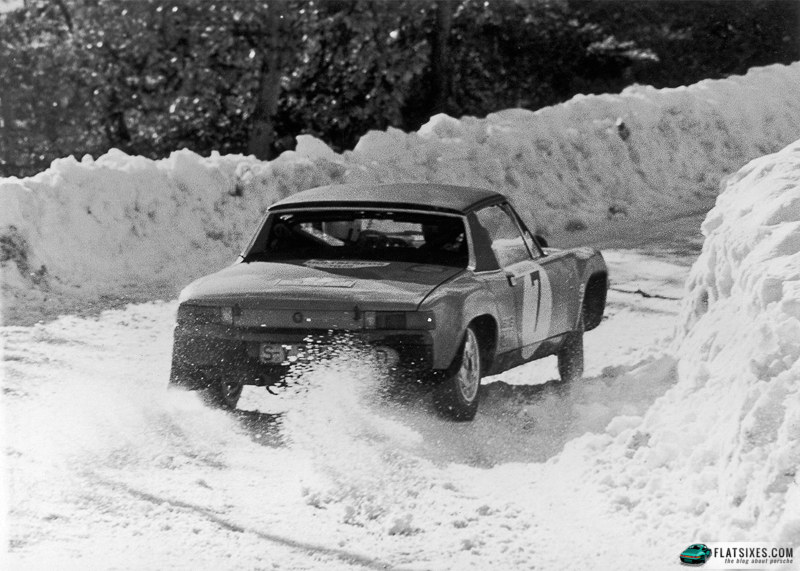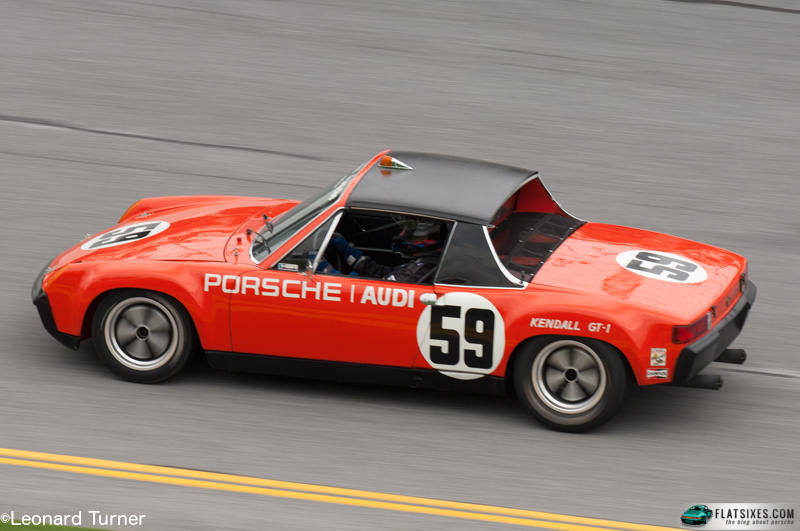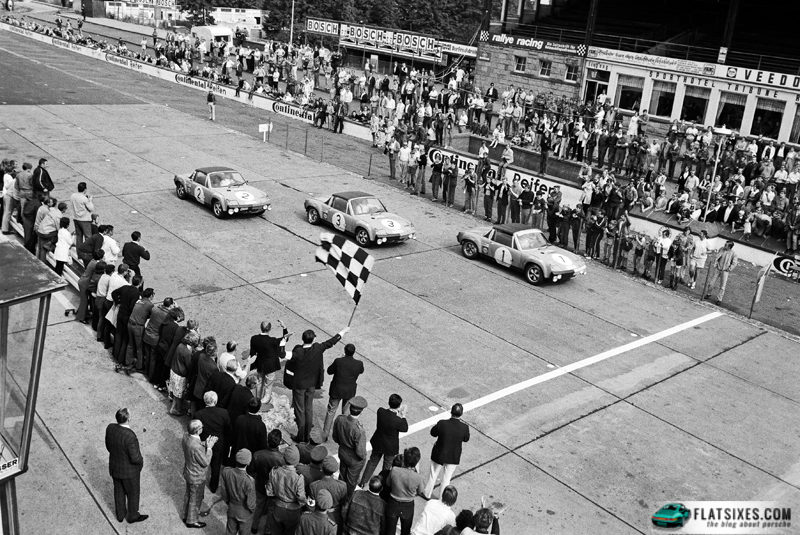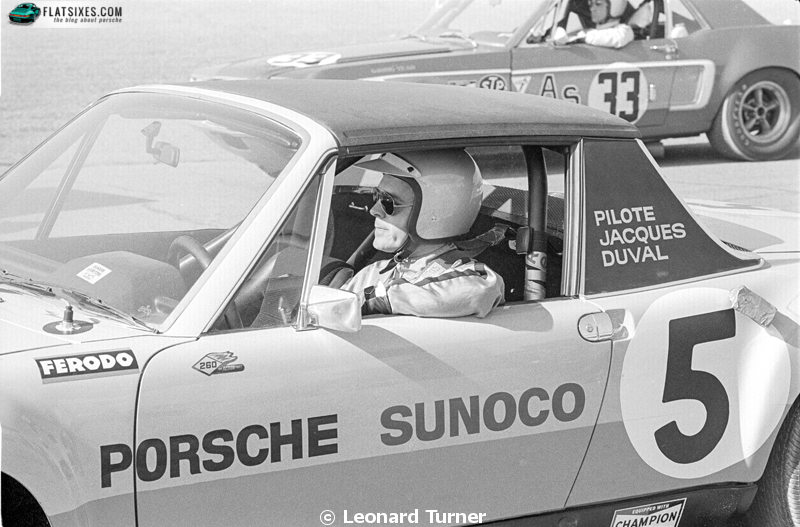
Even as the 914 was making its public debut at the 1969 Frankfurt Show, Ferry Porsche received an unusual 60th birthday present: a street-legal 914 fitted with a slightly detuned version of the potent 908 racing engine.
Distinguishing features of the special 914/8 included an external fuel filler on the right side of the cowl (an idea originally intended for the production 914 but omitted because of cost), wider headlight lids with two smaller round lights behind each, subtly flared fenders to make space for wider tires, and a single opening on the front bumper for the engine oil cooler. Porsche made good use of his gift, putting nearly 10,000 road-going kilometers on the 914/8 before European noise restrictions made it illegal.
Only one other 914/8 was built. For chief engineer Ferdinand Piëch the experimental department installed a full bore 908 racing engine, firm Bilstein shocks, and special titanium rear coil springs. Not officially licensed for the road, Piëch’s toy churned out a visceral 300 horsepower even when fitted with a street exhaust. Rarest of all 914s, the two 914/8 roadsters, never intended for series production, comprehensively established that the 914 chassis could take far more power than it was initially delivered with, a fact that would be proved over and over by the race-going 914/6s that followed.
To counteract the difficulty of selling the 914/6 (at a price that was way too close to that of the 911T), an ambitious program of competition was planned for 1970 and 1971, to include endurance racing, rallying and sprint racing. In the United States, the venue was the Sports Car Club of America’s C-Production class where the 914/6 faced strong factory supported Datsun and Triumph teams. In 1970 the new Porsche won four of seven divisional championships with nine 914/6 drivers qualifying for the Runoffs at Road Atlanta. There, unfortunately, the extra torque from their bigger engines gave the 240Z brigade the solid advantage and a dominant win.

After five straight years of warm conditions that would have favored the handling abilities of the 914/6 GT, the 1971 Monte Carlo Rally was run in the worst weather in decades.
While SCCA racing allowed few modifications to the 914/6 as it was homologated with the club, the FIA international regulations for GT cars permitted more latitude. By the winter of 1969, Porsche was preparing the 914/6 for homologation in Group 4 for Special GT Cars. By the time they were done, they had a new model. The 914/6 GT, homologated in March 1970, featured bulging steel fender extensions providing room for wider wheels. There were frame reinforcement plates where the rear springs and suspension arms were mounted, stronger lower wishbones at the front, and antiroll bars. Racing 911S brakes were added along with plexiglas windows and fiberglass body panels. The engine was kept at two liters, for homologation purposes, with dual ignition and Weber carburetors. The 914/6 GT weighed in at 1980 pounds, its engine producing a minimum of 210 DIN horsepower at 8000 rpm.
914/6 Posts Strong Racing Debut
Its first test came at the 1000 Km of the Nürburgring on May 30. Porsche 908/03s would take the overall victory, but in an auspicious debut race 914/6 GT models finished 2-3-4-5 only five seconds behind the class-winning 911L. At Le Mans barely a month later, the 914/6 GT wrote its own history. While Porsche was preoccupied with seven 917s and the effort to achieve the company’s first overall victory at the Sarthe, a 914/6 GT, entered by Sonauto and driven by Guy Chasseuil and Claude Ballot-Lena, scored an astonishing class win. The lone 914/6 GT in the field finished ahead of all other GT cars and classes, coming home a stunning sixth overall. It went the entire 24 hours without changing tires or brake pads.

Hurley Haywood and Peter Gregg dominated the inaugural season of the International Motor Sports Association, claiming the GTU driver and manufacturer championships in 1971.
Success continued in August at the Marathon de la Route, an 86-hour ultra endurance test over the north (“Green Hell”) and south loops of the iconic Nürburgring circuit. Porsche fielded three 914/6 GTs. All were signal orange, each with half its front bumper painted a different neon color for easy identification from the pits. One of the three was a standard 914/6 GT Group 4 car. The other two had to run as Group 6 prototypes because they had extra wide fender flares at the rear to permit eight-inch wide rims and 908 front brake calipers allowing thicker brake pads designed for longevity—changes in aid of minimizing time in the pits.
Raw speed was not as important as stamina and the engine chosen was the 160 horsepower version from the two-liter 911S. In a contest where only 23 of 64 starters made it to the finish, the brightly painted 914/6 GTs claimed all three spots on the podium. The two Group 6 prototypes came home ahead of the Group 4 car, the winning roadster driven by Gerard Larrousse, Claude Haldi and Helmut Marko. Once again, the 914/6 GT demonstrated its resolute strength. There was one tire change at the 80-hour mark and no brake pad replacements at all during the four non-stop days and nights of competition.

Porsche 914/6 GTs dominated the 86-hour Marathon de la Route at the Nürburgring in 1970, finishing first, second and third in the grueling endurance contest.
The three Marathon cars had one more mission at the end of January 1971. On the strength of its successes at Le Mans and the Nürburgring, Porsche decided the 914/6 GT would make its official works rally debut at the 1971 Monte Carlo Rally. Three new 914/6 GTs were completed late and the Marathon cars were pressed into service as test vehicles. Porsche had won the famous rally in 1968, 1969 and 1970 with 911s and their works drivers were uniformly glum about the prospect of competing with the 914/6. The rear weight bias of the 911 was better for snow, they argued.
Still, for the last several years, the rally had been run in warm conditions that would favor the handling virtues of the 914/6 and there continued to be a need to bolster its image. Unfortunately January of 1971 produced the worst weather in decades for the Monte. There would be mechanical issues as well. While two of the 914/6s suffered transmission and clutch difficulties before retiring, Bjorn Waldegaard brought the lone remaining example to the finish first in class, tied for third overall with a Renault-Alpine. It was a disappointing result in the face of the 911’s many successes at the Monte and Porsche did not continue the rally program with the 914/6.
The very next day, on another continent, the 914/6 GT proved that endurance racing was its true forte with a one-two class win at the Daytona 24 Hour, Jacques Duval, George Nicholas and Bob Bailey coming home seventh overall. At Sebring in March, Peter Gregg and Hurley Haywood drove the best placed 914/6 GT, finishing second in the Under Two Liter category behind Bert Everett’s 911T.

One of the first l14/6 GTs to come to North America was owned by Canadian racer Jacques Duval. He, George Nicholas and Bob Bailey drove it to seventh overall and first in class at the 1971 24 Hours of Daytona
The Sebring event was but a foreshadowing of the season that was to follow for the Jacksonville based team. The International Motor Sports Association opened its first season with an event at Virginia International Raceway in April, the first of a six race series for GTO and GTU cars along with former Trans-Am cars from the TO and TU groups. The Brumos pair drove their red 914/6 GT not only to the GTU victory that day but scored the outright win as well. They would repeat that result at Bridgehampton and Summit Point as well. It was an utterly dominant effort that made Porsche the Under 2.5-liter Champion in IMSA’s first year as a sanctioning body, brought Hurley Haywood and Peter Gregg the first IMSA GT driving championship and solidified the 914/6 GT’s place in the history of American sports car racing.
